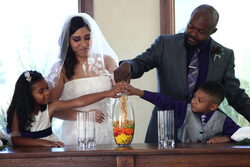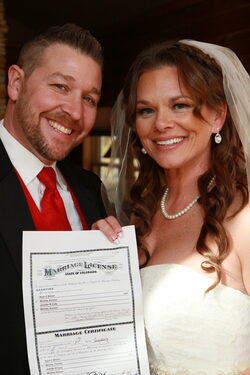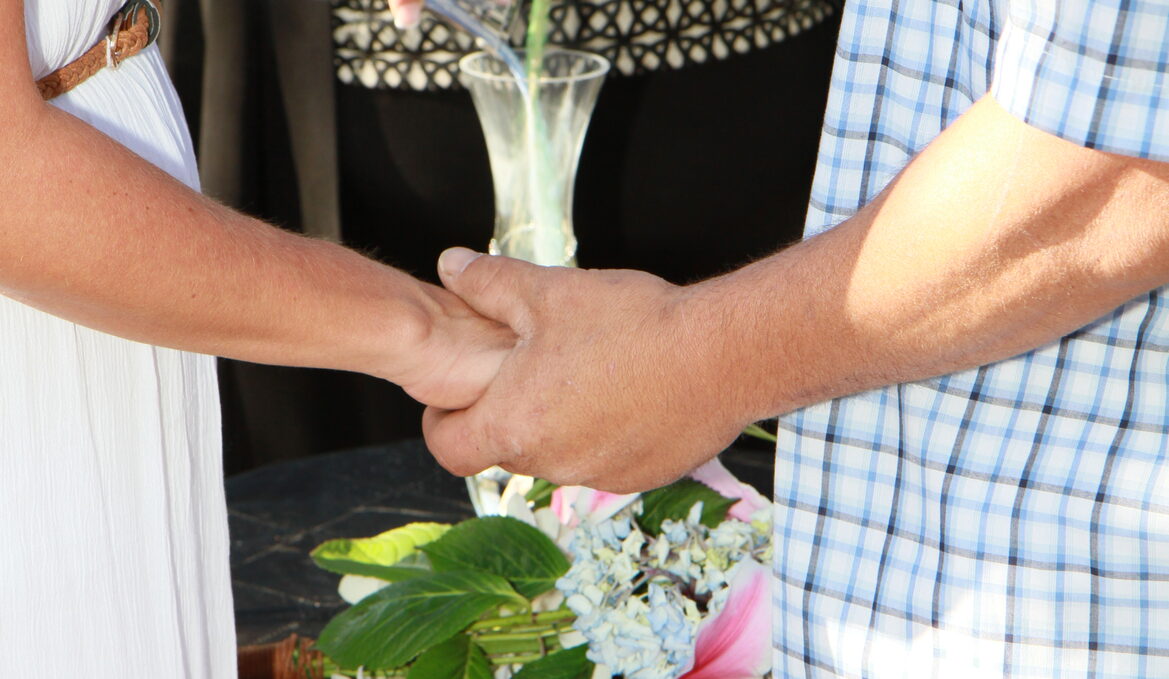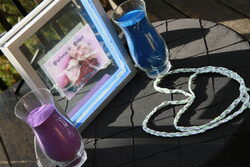Wine
In this unity ceremony, the couple takes a bottle of wine and pours two glasses for themselves. As they pour the wine, the officiant explains that the wine signifies the friends and family members of the couple. As they pour the wine the officiant explains that the wine signifies the friends and family members of couple. The officiant will then let the couple drink the wine, indicating that they are blending together their separate lives into one, creating a new family and friends.
This also can be modified to 1 glass of wine, shots, or even as a champagne toast for everyone!
Wine with Love Letter Box
This addition allows you to write letters to each other, telling each other how you fell in love, what it means to you and what your heart has to say. These letters are sealed and placed in a box, with the thought that you will open them on an anniversary, or when there is a challenge in your relationship. Many couples also add the bottle of wine they drank from to this box; however we do recommend using an unopened bottle as the opened bottle may leak over time.
You do not have to add the wine, and this is a quick unity to be added to any celebration, including an elopement. You can even substitute your letter with your personal vows to be reread to each other again on an anniversary or a time of distress.
Chocolate
A popular unity ceremony with elopements. A fast, fun, and tasty way to tell each other you love one another and confirming your vows that you have just made. The premise this unity is that when you bit into the chocolates, it may be a bitter, signifying that life may hold some bitterness, some darkness. But then the sweetness of the chocolate comes through and lets you know that no matter what the sweet love you share will always conquer the darkness.
Roses
This unity ceremony celebrates those who are special in the couples lives. These roses are traditionally given to a female relative such as a mother, grandmother, aunt, or even a friend of the family. This can be done by the couple, the flower girl, or an honored guest. Also, the roses can be given between the couple showing their love for one another, and as their first gift to each other as a married couple. You can even choose colors to reflect the feelings that couple has for the rose recipient. For example- Red- love/passion, dark pink- appreciation/gratitude, yellow-friendship/joy, peach-friendship/joy. You can even just use roses that match your wedding colors.
Truce Bell
The philosophy behind this unity is that even though you are two people who love each other, at times you may have disagreements. This bell that is rung during your ceremony is reminder of that love and a signal for a break in the discussion. This bell can be a treasured heirloom or maybe a cool find at a local shop. It is usually placed in the central part of the home for that tangible reminder of your day and for easy access.
Tea
For many couples this small act pouring tea for each other, the get to show a very valuable characteristics of their relationship. The deep shared desire to express your love by doing things for one another, to help each other, and to look after wellbeing of your spouse. This unity shows that you can help each other, lean on each other for strength, encouragement and hope. You get to show appreciation and symbolizing humility along with trust. As with many unities, this can be easily adapted to include others and can generally be done in an outdoor setting.
Lasso
A traditional unity dating all the way back to the Aztecs, this unity has Christian overtones and can be used with a corded rope, flowers or even a special rosary. Typically, the couple has a couple, frequently called patrons who stand up and place the Lasso around the couples shoulders, in the form of an infinity symbol (a figure 8) after they have exchanged their vows, acknowledging their union. This is usually done by the officiant; however, family members can also take part in this ritual. The couple wears the lasso throughout the remainder of the service. The couple then wears it until the end of ceremony.
Arras or 13 Coins
Possibly one of the oldest of all unity ceremonies, this unity may go all the way back to the Romans, when the custom was to break a gold or silver coin, with each half given to the wedding couple as the pledge of marriage. Another theory is that this unity originated in Spain, where the groom gave 13 gold coins to the bride to show that he could support her. With many ways of presentation, the most common ways are to have the ‘patrons’ bring up to the couple a tray or small golden box that contains 13 small gold coins. One of the ‘patrons’ gives the coins to one of the wedding couple, then counts out the coins to the other party, as the officiant explains what they mean. The 13 coins represent different values that the couple desire to share between themselves: love, harmony. cooperation, commitment, peace, happiness, trust, respect, caring, wisdom, joy, wholeness and nurturing. Once given the ceremony is reversed and the coins are given back to show their dedication to the marriage. Finally, the coins are collected and given back to the ‘patrons’ and they are now seated.
This unity ceremony is often combined with the Lasso unity and works in an outdoor and indoor setting.



